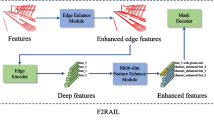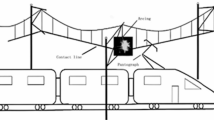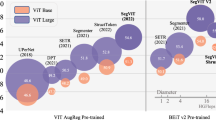Abstract
The pantograph-catenary arcing reflects the health of pantograph-catenary and current collection quality of high-speed railway, so the arc detection is of great significance. However, due to the scene complexity, intra-class polymorphism and inter-class similarity of arcing and the fast running speed of high-speed railway, it is still a huge challenge to achieve fine and robust arcing detection. To overcome these issues, a robust and fast image-based instance segmentation method called ArcMask is proposed to detect pantograph-catenary arcing, which designs a new attention-based multi-scale feature fusion module that combines both top-down and down-up modules to realize arcing pixel-level instance segmentation. The effective combination of instance-level information and bottom-level semantic information balances features representation ability of top-level and bottom-level features. Compared with other instance segmentation methods (e.g., BlendMask), it can effectively learn feature representation with tiny, irregular and complex arc features and speeds up the calculation. In addition, both deformable convolution and depth-wise separable convolution are introduced in ArcMask, which aims to improve the segmentation performance of irregular arcing and efficiency. The ArcMask can distinguish different arcing instances at pixel-level with fine granularity and distinguish inter-class and intra-class features of arcing, instead of just focusing on rectangular bounding box. Experiments on self-collected dataset IVAIS-PCA2021 verify the effectiveness and efficiencies of the ArcMask. Its AP, AP50 and AP75 are 56.61, 94.14 and 64.56, respectively, and the fastest reasoning speed based on MobileNet is 56 FPS. Compared with other state-of-the-art segmentation methods, the proposed ArcMask has better integrity in arcing edge detection.


















Similar content being viewed by others
Explore related subjects
Discover the latest articles, news and stories from top researchers in related subjects.Data availability statement
Data sharing is not applicable to this article as no datasets were generated or analyzed during the current study.
References
Gao S, Liu Z, Yu L (2017) Detection and monitoring system of the pantograph-catenary in high-speed railway (6C). In: Proceedings of 2017 7th international conference on power electronics systems and applications-smart mobility, power transfer & security, pp 1–7
Gao S (2020) Automatic detection and monitoring system of pantograph–catenary in China’s high-speed railways. IEEE Trans Instrum Meas 70:1–12
Huang S, Chen W, Sun B et al (2020) Arc detection and recognition in the pantograph-catenary system based on multi-information fusion. Transp Res Record 2674(10):229–240
Lu P et al (2019) Information fusion and image processing based arc detection and localization in pantograph-catenary systems. In: Proceedings of 2019 22th international conference on information fusion, pp 1–8
Barmada S, Raugi M, Tucci M et al (2014) Arc detection in pantograph-catenary systems by the use of support vector machines-based classification. IET Electr Syst Transp 4(2):45–52
Wei W, Liang C, Yang Z et al (2019) A novel method for detecting the pantograph–catenary arc based on the arc sound characteristics. Proc Inst Mech Eng F J Rail Rapid Transit 233(5):506–515
Gao G, Yan X, Yang Z et al (2018) Pantograph-Catenary arcing detection based on electromagnetic radiation. IEEE Trans Electromagn Compat 61(4):983–989
Aydin I, Karaköse M, Akin E (2012). A new contactless fault diagnosis approach for pantograph-catenary system. In: Proceedings of 15th international conference MECHATRONIKA, pp 1–6
Aydın İ, Yaman O, Karaköse M et al (2014) Particle swarm based arc detection on time series in pantograph-catenary system. In: Proceedings of 2014 IEEE international symposium on innovations in intelligent systems and applications, pp 344–349
Aydin I, Karakose M, Akin E (2015) Anomaly detection using a modified kernel-based tracking in the pantograph–catenary system. Expert Syst Appl 42(2):938–948
Karakose E, Gencoglu TM, Karakose M et al (2018) A new arc detection method based on fuzzy logic using S-transform for pantograph–catenary systems. J Intell Manuf 29(4):839–856
Aydin I (2015) A new approach based on firefly algorithm for vision-based railway overhead inspection system. Measurement 74:43–55
Huang S, Zhai Y, Zhang M et al (2019) Arc detection and recognition in pantograph–catenary system based on convolutional neural network. Inf Sci 501:363–376
Krizhevsky A, Sutskever I, Hinton GE (2012) Imagenet classification with deep convolutional neural networks. In: Proceedings of Advances in neural information processing systems, pp 25
Karaduman G, Karakose M, Akin E (2017) Deep learning based Arc detection in pantograph-catenary systems. In: Proceedings of 2017 10th international conference on electrical and electronics engineering, pp 904–908
Woo S, Park J, Lee JY et al (2018) Cbam: Convolutional block attention module. In Proceedings of the European conference on computer vision, pp 3–19
Chollet F (2017) Xception: Deep learning with depthwise separable convolutions. In Proceedings of the IEEE conference on computer vision and pattern recognition, pp 1251–1258
Dai J, Qi H, Xiong Y et al (2017) Deformable convolutional networks. In Proceedings of the IEEE international conference on computer vision, pp 764–773
Tan M, Pang R, Le QV (2020) Efficientdet: Scalable and efficient object detection. In Proceedings of the IEEE/CVF conference on computer vision and pattern recognition, pp 10781–10790
Liu S, Qi L, Qin H et al (2018) Path aggregation network for instance segmentation. In: Proceedings of the IEEE conference on computer vision and pattern recognition, pp 8759–8768
Chen LC, Papandreou G, Schroff F et al (2017) Rethinking atrous convolution for semantic image segmentation. ArXiv Preprint, arXiv:1706.05587
He K, Gkioxari G, Dollár P et al (2020) Mask r-cnn. IEEE Trans Pattern Anal Mach Intell 42(2):386–397
He K, Zhang X, Ren S et al (2016) Deep residual learning for image recognition. In Proceedings of the IEEE conference on computer vision and pattern recognition, pp 770–778
Howard A G, Zhu M, Chen B et al (2017) Mobilenets: Efficient convolutional neural networks for mobile vision applications. ArXiv Preprint, arXiv:1704.04861
Lee Y, Hwang J W, Lee S et al (2019) An energy and GPU-computation efficient backbone network for real-time object detection. In Proceedings of the IEEE/CVF Conference on Computer Vision and Pattern Recognition Workshops
Qin X, Zhang Z, Huang C et al (2020) U2-Net: Going deeper with nested U-structure for salient object detection. Pattern Recognit 106:107404
Chen H, Sun K, Tian Z et al (2020) Blendmask: Top-down meets bottom-up for instance segmentation. In Proceedings of the IEEE/CVF conference on computer vision and pattern recognition, pp 8573–8581
Acknowledgments
This work was supported by National Natural Science Foundation of China (Grant No. 52277127), Science and Technology Innovation Talent Project of Sichuan Province (Grant No. 2021JDRC0012), Independent Research Project of National Key Laboratory of Traction Power of China (Grant No. 2019TPL-T19), Key Interdisciplinary Basic Research Project of Southwest Jiaotong University (Grant No. 2682021ZTPY089), Open Research Project of National Rail Transit Electrification and Automation Engineering Technology Research Center and Chengdu Guojia Electrical Engineering Co., Ltd (Grant No. NEEC-2019-B06), and State Scholarship Fund of China Scholarship Council. (Grant No. 202007000101).
Author information
Authors and Affiliations
Corresponding author
Ethics declarations
Conflict of interest
The authors declare no competing interests.
Additional information
Publisher's Note
Springer Nature remains neutral with regard to jurisdictional claims in published maps and institutional affiliations.
Rights and permissions
Springer Nature or its licensor (e.g. a society or other partner) holds exclusive rights to this article under a publishing agreement with the author(s) or other rightsholder(s); author self-archiving of the accepted manuscript version of this article is solely governed by the terms of such publishing agreement and applicable law.
About this article
Cite this article
Quan, W., Guo, S., Lu, X. et al. ArcMask: a robust and fast image-based method for high-speed railway pantograph-catenary arcing instance segmentation. Neural Comput & Applic 35, 6875–6890 (2023). https://doi.org/10.1007/s00521-022-08059-7
Received:
Accepted:
Published:
Issue Date:
DOI: https://doi.org/10.1007/s00521-022-08059-7




